
Wear sunscreenImage source: Paul Prescott
If you want a sunscreen that doesn’t sting your eyes, is free from harmful ingredients and helps prevent skin cancer – read this guide.
Recently updated to include new reviews, an easy comparison table and reef safety guidance.
I’ve been doing lots of research and trying out different products to find the best sunscreen for surfers. Here’s the results:
What’s the best sunscreen for surfers?
The best type of sunscreen for surfers is very water resistant, gives UVA and UVB protection, and ideally contains non-nano zinc oxide and/or titanium dioxide.
If you don’t have the time to read this guide, this advice will help you choose a good sunscreen for surfing. If you want to be better informed, read on or visit 10 Over Surf Shop.
Does sunscreen prevent skin cancer?
Seems like a silly question, but reputable media sources e.g. The Guardian have asked the same question, and the answers are by no means conclusive. A study published in Nature (a science journal) stated that sunscreen ‘only provided partial protection’.
To save you reading all the techy science jargon, the summary is: yes, sunscreen can help prevent skin cancer. But avoiding sun exposure is better, and if you do need to go out in the sun cover up and wear sunglasses.
The Aussies have a lot of experience with skin cancer and sun protection. Australia’s Cancer Council recommend the 5 S’s:
• slip – slip on a shirt
• slop – slop on some sunscreen
• slap – slap on a hat
• seek – seek some shade
• slide – slide on some wrap-around sunglasses
What is SPF?
SPF stands for Sun Protection Factor and is the big number on your sunscreen bottle. It’s an indication of the level of protection against the sun’s effects. Roughly speaking, if you have a SPF15 cream, it will give you 15 times the protection of having no cream. So if you burn after ten minutes in the sun with no protection, SPF15 theoretically gives you 2.5 hours protection before you burn.
It’s not as simple as that unfortunately, as many other factors besides the SPF have an affect. For example, swimming, sweating, any abrasion from clothes or a towel will all reduce the amount of protection, as they remove some of the sunscreen. How well you apply the sunscreen in the first place also affects the effectiveness.
You should choose a sunscreen with between SPF15 and SPF50. Any lower than SPF15 you won’t be getting effective protection, any higher than 50 offers very little in terms of extra protection. For example, SPF50+ filters out 98% of UVB radiation compared to 96.7% blocked by SPF30+, according to Cancer Council Australia.
UVB and UVA
In short, you want a sunscreen that will protect you from both UVB and UVA. SPF is primarily concerned with blocking UVB.
UV stands for Ultra Violet, and refers to the light radiation emitted by the sun. UV sun radiation is transmitted in three wavelengths – UVA, UVB and UVC. We only need to protect ourselves from UVA and UVB, as UVC can not penetrate the earth’s atmosphere.
UVB causes sunburn and increases the risk of skin cancer. UVA has long been known to cause ageing of the skin, but it’s only recently been discovered as a contributing cause of skin cancer.
Some sunscreens indicate the level of UVA protection using stars, with 5 star being good and 1 star bad.
However, 5 star UVA protection on a low SPF cream will not offer good all round sun protection. What you need to look for is a ‘broad spectrum’ cream with a high SPF and lots of stars. Ideally SPF30-50 with 4 or 5 stars.
The Vitamin D issue
Vitamin D helps the body absorb calcium, and calcium is required to keep bones, teeth and muscles healthy. A lack of Vitamin D can cause soft bones in children (rickets) and misshapen bones in adults (osteomalacia).
The problem is the best source of vitamin D is from the sun’s UV radiation, which is also a major cause of skin cancer. So a sensible balanced approach is required.
In most parts of the world, you can get the required daily dose of vitamin D by spending a little time outdoors. If you spend a lot of time outside or there’s a risk of sunburn, then sun protection is advised.
Sun cream vs sun spray
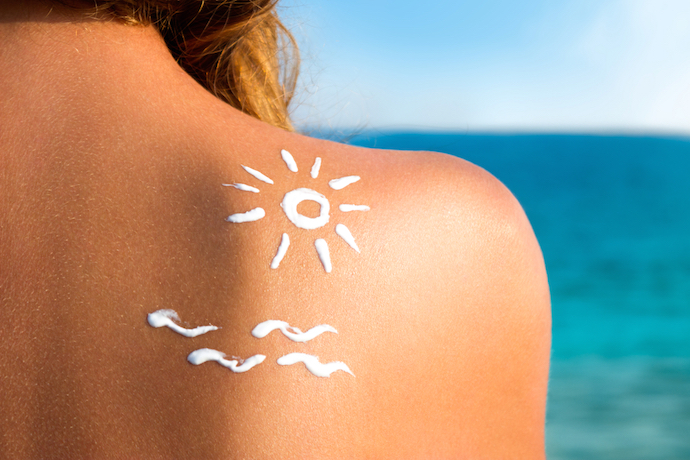
Looks pretty but works better when rubbed inImage source: Cherries
Cream can be a bit messy and difficult to evenly apply, but virtually every site I researched say ‘do not use spray’. I personally find sprays quick and easy to apply, but that’s half the problem. Because the spray is so fine and easily absorbed, it’s difficult to see where the sun spray has covered and more importantly not covered. So missed bits get burned, and it’s easy to apply too little.
The other half of the issue is spray can easily get inhaled. The chemicals and minerals in sun cream can be harmful when applied to skin (more on that in a bit), but swallowing them should definitely be avoided. If you want to use sprays, then spray onto your hands first and away from the face.
Creams are still the best option when applied liberally and evenly. They might take a little longer to apply and soak in, but they are likely to last longer and offer better protection.
Chemical vs mineral
I like natural stuff as much as the next person, but when it comes to preventing skin cancer I get increasingly skeptical. So does the natural sunscreen work as good as the chemical stuff?
Chemical sunscreens are usually easy and smooth to apply, plus they’re often invisible once soaked in. Mineral sunscreens are often thicker and can leave the skin looking pale. This is because chemical sunscreens work differently from mineral sunscreens.
Chemical sunscreens soak into the skin and allow UV radiation to be absorbed. This means UV radiation reaches deeper into your skin, potentially causing damage.
Mineral sunscreens containing zinc oxide and/or titanium oxide create a barrier upon the surface of your skin and reflect UV radiation. This helps prevent UV radiation penetrating your skin and causing damage.
Mineral sunscreen also works immediately and is usually suitable for sensitive skin (zinc oxide is used in nappy cream). Chemical sunscreen needs time to soak into your skin (usually 15 minutes) before it’s effective and can irritate sensitive skin. Some ingredients in chemical sunscreen have even been reported as causing disturbances in hormones and sperm!
Harmful sunscreen ingredients
Oxybenzone is a common sunscreen ingredient and is placed at the top of the Environmental Working Groups (EWG) toxicity table. It acts like estrogen, alters sperm production in animals and is associated with endometriosis in women. It’s also likely to cause an allergic skin reaction if you’re prone to such things.
Octinoxate and homosalate are also widespread in chemical sunscreens, potentially causing similar issues. You can add octocrylene to your list as well. Having said all that, all of these chemicals are found in mother’s milk and only limited studies have been conducted. So the level of risk is debatable.
Parabens including methylparaben, propylparaben, butylparaben, and ethylparaben are commonly used in sunscreens and cosmetics as a preservative. Parabens have been associated with breast cancer, hormone development and premature skin aging. However, official sources including the FDA and NHS say there’s no proof that parabens are harmful but further research is required.
Other ingredients to look out for particularly if you have sensitive skin are petroleum, silicones and synthetic fragrances. Used to make the cream feel smooth and smell nice but can cause skin irritation.
Using chemical sunscreen is better than getting burnt, but mineral sunscreens without these chemical ingredients is the logical choice for me.
Good ingredients

Minerals and natural ingredientsImage source: Kerdkanno
Look for mineral sunscreens containing zinc oxide and/or titanium oxide. They don’t penetrate the skin and reflect UV rays, so they’re potentially safer (unless you eat them).
However, to avoid the ghostly shade created by the layer of minerals some sunscreens use nanoparticles. The nanoparticles mean you avoid looking like Caspar the friendly ghost, but there are concerns the particles might be absorbed by the skin. Current research indicates these fears are unwarranted.
Read the ingredients before you buy your next sunscreen, and remember not all mineral sunscreens are free from chemicals.
Reef safe sunscreens
Many of the same chemicals that are harmful to humans are unsafe for our ocean life too.
The National Ocean Service cites a scientific study that found Oxybenzone, or BP-3, to be highly toxic to juvenile corals and other marine life. Four major toxic effects in early, developing coral were highlighted by the study:
1. increased susceptibility to bleaching
2. DNA damage (genotoxicity)
3. abnormal skeleton growth
4. gross deformities of baby coral
Benzophenone-2, or BP-2, was found to have similar harmful effects according to a separate study.
The Coral Reef Alliance report other potentially harmful sunscreen ingredients including Octinoxate, Benzophenone-1, Benzophenone-8, OD-PABA, 4-Methylbenzylidene camphor, and 3-Benzylidene camphor.
Studies published in 2018, have shown Octocrylene could impair coral metabolism. Other organisations such as Save The Reef include Homosalate, Parabens and Triclosan in their list of ingredients to avoid.
Don’t rely on ‘reef safe’ or ‘reef friendly’ claims by sunscreen producers, as these terms are unregulated. Instead check the sunscreen’s ingredients list. If you want to avoid all the ingredients that could cause coral harm, choose a non-nano mineral sunscreen.
Applying sunscreen
Whatever sunscreen you prefer, you must put it on evenly and liberally over all exposed areas. If you apply sunscreen in a rush or half-heartedly, you’re bound to miss bits. If you need help reaching awkward areas, ask someone to help. Being bashful will get you burnt! You should also apply sunscreen 15 minutes before going in the sea.
The 15 minutes thing is important. Some sunscreens soak in quicker and better than others. Mineral sunscreens work immediately. But if you put on sunscreen just as you’re about to enter the water it’ll wash straight into your eyes and sting like hell.
So if there’s a chance of sunshine and you’re planning a surf, put on sunscreen before you grab your board and go. That way the sunscreen will soak in on your way to the beach and you’re less likely to get sore eyes.
Water-resistant sunscreen reviews
I’ve recently tried and tested a range of sunscreens to see how they fair when surfing. All are labelled as very or extra water-resistant, and offer some degree of UVA protection.
This is not a scientific study, just my honest opinion.
Sett Surf
• SPF – 30
• Chemical or mineral – mineral
• Nanoparticles – no
• Reef safe – yes
• Key ingredients – zinc oxide, titanium dioxide
• Price – £24.99 for 200ml
• More info at Sett Surf
Sett Surf products are natural, preservative free, reef safe and tested on surfers. The latest version contains zinc and titanium dioxide for sun protection, also aloe vera to nourish your skin. For the full sun care set try the lip balm and face stick too.
The version I tried two years ago rubbed in well, smelled pleasantly medicinal, didn’t sting the eyes and stopped my bald head getting burnt when tested on sunny surf sessions. The latest version apparently has ‘no ghosting effect’ and the new natural ingredients are likely to smell even better.
Summary: natural choice of sun care options, surfer-friendly.
Standard Procedure
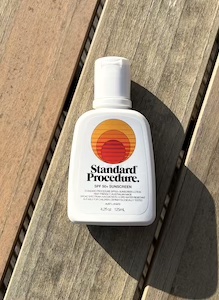
Standard Procedure Sunscreen
• SPF – 50+
• Chemical or mineral – chemical
• Nanoparticles – no
• Reef safe – contains octocrylene
• Key ingredients – homosalate, octocrylene, ethylhexyl salicylate
• Price – £20 for 125ml
• More info at Standard Procedure
Trusty Aussie sunscreen, lovingly made in the solar-powered family factory in Queensland. Although chemical based, it is free from the worst offenders PABA, Parabens, Oxybenzone & Octinoxate. Mixed in are some Australian superfruits for a vitamin and antioxidant boost.
Applies easily, soaks in quickly, leaves no noticeable residue and smells like fruity sunscreen. No stingy eyes even during hot sweaty coastal runs and my delicate head remained sunburn free. Bonzer!
Summary: brilliant all-rounder.
Ride Skincare
• SPF – 25
• Chemical or mineral – mineral
• Nanoparticles – none
• Reef safe – yes
• Key ingredients – titanium dioxide
• Approx price – £11.99 for 50ml
• More info at Ride Skincare
Developed specifically for riders of the mountains, roads and sea. Due to the candelilla wax it does feel a bit like gloss paint on application, but it soaks in surprisingly well and the wax makes it super water resistant.
Worked great in the sea and passed the stingy eye test. Smells pleasantly medicinal with a hint of coconut. I interviewed the creator Tom Marshall when they launched their skincare range, and he had some interesting stuff to say. Read the interview and learn more here.
Summary: Great ingredients and works a treat in the surf.
Nivea Kids
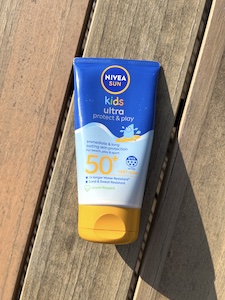
Nivea Kids sunscreen
• SPF – 50
• Chemical or mineral – both
• Nanoparticles – yes
• Reef safe – contains Titanium Dioxide (nano)
• Key ingredients – Titanium Dioxide (nano)
• Price – £8 for 150ml
• More info at Nivea
Nivea is an old family favourite and their high factor kids range offer high levels of sun protection and extra water resistance. It’s a lot cheaper than the others reviewed so far and you can buy it just about anywhere.
The new Kids Ultra Protect and Play SPF 50 has a new biodegradable formula that excludes harmful chemicals and uses titanium dioxide nano instead. Nivea is clearly making a positive effort, but the nano bit is still contentious for many. Personally I’m impressed, I’ve used on long sweaty runs and surfs without stingy eyes or sunburn.
Summary: cheap, easy to apply and effective.
Sun Bum

Sun Bum sunscreen
• SPF – 50
• Chemical or mineral – chemical
• Nanoparticles – no
• Reef safe – contains Octocrylene
• Key ingredients – Avobenzone, Homosalate, Octisalate, Octocrylene
• Price – £18.49 for 177ml
• More info at Sun Bum
Sun Bum is a Californian cream widely sold in UK surf shops and apparently water resistant for 80 minutes, so I thought I’d give it a go. It’s vegan and free from cruelty, gluten, parabens, Oxybenzone, Octinoxate, Oil and PABA. Whilst Hawaii Act 104 reef compliant, it does contain Octocrylene and Homosalate which is on some organisations harmful list.
Easy to apply, absorbs into the skin fast, smells like a chemically coconut and stopped me getting sunburn on short surf sessions. But disappointingly it does sting the eyes. They’ve recently released a mineral based version called Baby Bum that might be worth a try.
Summary: Works for short surf sessions, but too chemically for my liking.
Island Tribe
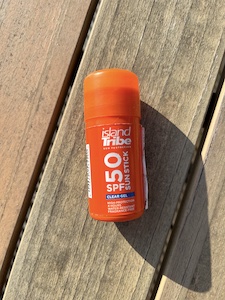
Island Tribe face stick
• SPF – 50
• Chemical or mineral – chemical
• Nanoparticles – no
• Reef safe – contains Octocrylene
• Key ingredients – Octocrylene
• Price – £14 for 30g
• More info at Island Tribe
After many recommendations and unable to find the clear gel 100ml tube, I bought the sun stick. Pocket-friendly, travel-friendly, squish and spill proof the stick has benefits. With a claimed 4 plus hours of water resistance it sounded too good to be true.
I eagerly tested this stick on my surf trip to Senegal and it stood up to long and heavy surf sessions in the African sun. Quick and easy to apply it’s difficult to believe it’ll work, but it does! Whilst great for my hairless noggin, it’s not ideal for all-over application. I’m sure the compact stick reduces waste compared to creams and sprays but I’m not convinced they offer better value for money.
Summary: Top notch noggin sun protection, suitable for face, feet and arms.
Surf sunscreen comparison
Here’s a convenient table to summarise the sunscreens I’ve recently tested and reviewed. Ratings are personal opinion and consider all factors mentioned in my reviews.
Brand | Rating | Price per 100ml* |
Sett Surf | £12.50 | |
Standard Procedure | £16.00 | |
Ride Sunscreen | £24.00 | |
Nivea Sun Kids | £5.30 | |
Sun Bum | £10.45 | |
Island Tribe | £43.00** |
* All prices were correct at time of publishing. Shop around and you may find a better deal.
** Island Tribe face stick is solid and measured in grams not millilitres. So I calculated price based on 30g equals 30ml.
In my tests Sett’s latest sunscreen comes out top as it’s mineral based, affordable and works well. Standard Procedure is an excellent chemical based sunscreen, and the value of Nivea’s latest Kids Protect and Play product is hard to beat.
I’m currently using up a mix of the above and will be trying out new mineral sunscreens this summer. I’m still hunting for a cheaper, smoother, mineral cream for holidays, when I need to cream up from head to toe on a daily basis. Any recommendations gratefully received.
Sunscreen resources
If you want to read more about sunscreen, I recommend the following sources:
• British Association of Dermatologists
• EWG – Environmental working group

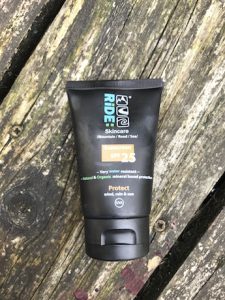
Thank you for the insightful info on sunscreen guide for surfers. Although I don’t want to jump into details, I enjoy the read and like becoming informed. Five minutes reading this is better than spending years dealing with Skin Cancer or lifelong deficiency of Vitamin D. However, I do hope that readers will get to the point where we are “told” which brands are good…I trust you guys, so can you not list the top 10? Or do a matrix of features? What do the pros use? What do you guys use?
Hi Brice,
I’m happy to share any other surfer’s recommendations, just leave a comment.
I currently use the Ride and Badger products for surfing as they’re the most water resistant and mineral based.
I’ll also be asking around and will try and update the post soon. I like the idea of a quick and easy table for comparison.
Thanks for the comment
Hi Brice,
I’m happy to share any other surfer’s recommendations, just leave a comment.
I currently use the Ride and Badger products for surfing as they’re the most water resistant and mineral based.
I’ll also be asking around and will try and update the post soon. I like the idea of a quick and easy table for comparison.
Thanks for the comment
Thank you for the insightful info on sunscreen guide for surfers. Although I don’t want to jump into details, I enjoy the read and like becoming informed. Five minutes reading this is better than spending years dealing with Skin Cancer or lifelong deficiency of Vitamin D. However, I do hope that readers will get to the point where we are “told” which brands are good…I trust you guys, so can you not list the top 10? Or do a matrix of features? What do the pros use? What do you guys use?
Wow – a bunch of research has gone into this, thanks! It’s good to get past all the marketing and actually pin down the truth. When I was young, my mum would always say that the SPF number was how regularly we needed to apply sunscreen again (in minutes)! We always overran the time (too much fun being had on the beach) but ultimately we’d remember and would reapply in a good time based on my mum’s secret knowledge of what SPF actually meant! I like the 5 S rule as well – will remember that for the future – still relevant even in cloudy Britain!
Hi Sarah,
Mother’s always know best! Glad you liked the post and thanks for taking the time to comment.
Good luck with the new Boardwalk Clothing website.
Hi Sarah,
Mother’s always know best! Glad you liked the post and thanks for taking the time to comment.
Good luck with the new Boardwalk Clothing website.
Wow – a bunch of research has gone into this, thanks! It’s good to get past all the marketing and actually pin down the truth. When I was young, my mum would always say that the SPF number was how regularly we needed to apply sunscreen again (in minutes)! We always overran the time (too much fun being had on the beach) but ultimately we’d remember and would reapply in a good time based on my mum’s secret knowledge of what SPF actually meant! I like the 5 S rule as well – will remember that for the future – still relevant even in cloudy Britain!
Hi Andrew
Got a new one for you to try…
After reading your blog ages ok, I relooked at this as was fed up getting stingy eyes, could find any of your top recommends locally, but after looking at whats on offer i found this one.
Island Tribe ( Annes Cottage) its a clear gel and works brilliantly, i spent 5 hours surfing yesterday and only had to apply the once. They offer 2 sizes, i spent £18 on the larger 100ml, defo worth it!
Hi Pete,
I like the idea of a clear gel, will definitely give that a try. Thanks for the tip off.
I’ve been testing all the creams I’ve listed and my current favourite is the Surf Durt. Because it’s light brown and more of a paste than a cream. So it doesn’t run into my eyes or make a mess and it actually gives me a more tanned appearance. Unlike a lot of creams that wash into my eyes when surfing, splurt everywhere and make me look pale. It also smells nice.
Look forward to testing the Island Tribe gel. Cheers
Hi Pete,
I like the idea of a clear gel, will definitely give that a try. Thanks for the tip off.
I’ve been testing all the creams I’ve listed and my current favourite is the Surf Durt. Because it’s light brown and more of a paste than a cream. So it doesn’t run into my eyes or make a mess and it actually gives me a more tanned appearance. Unlike a lot of creams that wash into my eyes when surfing, splurt everywhere and make me look pale. It also smells nice.
Look forward to testing the Island Tribe gel. Cheers
Hi Andrew
Got a new one for you to try…
After reading your blog ages ok, I relooked at this as was fed up getting stingy eyes, could find any of your top recommends locally, but after looking at whats on offer i found this one.
Island Tribe ( Annes Cottage) its a clear gel and works brilliantly, i spent 5 hours surfing yesterday and only had to apply the once. They offer 2 sizes, i spent £18 on the larger 100ml, defo worth it!
Hi there –
we are running a paddlesports school and outdoor pool in Switzerland and whilst looking for a cool sunscreen brand to supply our guests i came across your website. could you please tell me if you ship to Switzerland at all and if so, do you know how it works with taxes? also, if so, could you provide us with an offer for “Surfers Skin” (30 and 50) if we buy in bulks?
thanks a lot and have a great day
olivia
Hi Olivia,
Unfortunately I’m not a reseller for any of the sunscreen products I’ve reviewed, but if you’d like to buy Surfers Skin in bulk you can contact their European reseller:
Skinalive
Unit 10, Seabase Industrial Estate
Newquay
Cornwall
UK
TR7 2SX
Tel: +44 (0) 1637 875 811
Fax: +44 (0) 1637 877 114
Email: info@seabase.eu
https://skinalive.eu/contact/
How was your Cornwall surf camp in St Ives? I hope it went well.
Thank you so much! No more crispy noses regardless of the suncream application before going in the water! I was using Nivia, suffering with the ole stingy eye due to not realising the 15 mins rule and not knowing what I was putting on to my skin.
Hi Sophie, thanks for taking the time to leave a comment. It brightens my day knowing someone has read my post and found it useful. I hope your sunny water days will be even more enjoyable now. Cheers
Dear surferdad.co.uk admin, Thanks for the well-structured and well-presented post!
Hi Andrew, i am not a surfer or sporty in any way however i have Actinic keratoses which is basically abnormal cells caused by long-term damage from the sun, so i should wear sun protection every day regardless of the weather. this may not make sense, i rarely do but i have not been wearing any sunscreen as i cannot decide which one to use, i know what i want, something that is easy to put on, no white cast, not too thick, fragrance free or not a powerful smell and does not sting eyes and importantly a reasonably priced option as i need to use it daily. I have found the whole search process, painful, i would find one and think it will do but i know my skin needs more that it will just do..
So after that long paragraph (sorry about that), i will get to my point, you sir are brilliant, you have given a perfectly concise and very honest review on the sun protection you have tried and tested, i kid you not i must have been on numerous as in at least 50 if not more, websites looking at reviews and ingredients and so on. Your review has honestly been the most helpful and i really wanted to say thank you, i just had to go the long way around to say it lol.
In all honestly i think you should carry on with this even though it will take up your personal time, you have helped which i very much appreciate and like me there are a lot of non sports and non surfers out there that need this kind of genuine honest feedback. I hope more people reply with what products they use and their experience with them, (in my most creepiest voice) i will be watching you 😛
Wow, thanks for taking the time to add your great comment. It’s very much appreciated. I’ve been thinking about spending more time on the bog recently and this post will benefit from an update. So you’ve inspired me! Watch this space. If you’ve tried any sunscreen you think are good and worth sharing please let me know. Thanks again
Thanks for helping out, great information.
Thanks for keeping this updated. I’m going on holiday for 2 weeks and will be doing a lot of water activities.
Thanks for the thanks Hannah, hope the water activities on your holiday went well – and avoided sunburn!